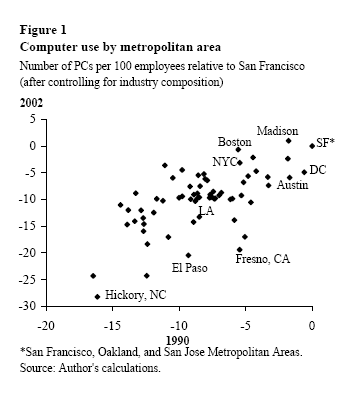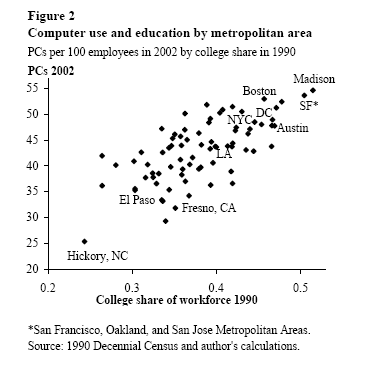For the last fifteen years or so, information technology (IT) has become an ever more important part of the U.S. economy. Looking back over the period, there can be little doubt that the growing use of IT contributed significantly to the economy’s performance, especially in the latter half of the 1990s, when output grew rapidly, unemployment declined to 25-year lows, productivity surged, and the inflation rate actually fell.
- Why technology diffusion is of interest
- The diffusion of personal computers
- The importance of human capital
- Spillovers from the IT-producing sector
- Computer adoption and wages
- Summary
- References
|
For the last fifteen years or so, information technology (IT) has become an ever more important part of the U.S. economy. Looking back over the period, there can be little doubt that the growing use of IT contributed significantly to the economy’s performance, especially in the latter half of the 1990s, when output grew rapidly, unemployment declined to 25-year lows, productivity surged, and the inflation rate actually fell.
A key question about IT’s role in this performance is how its use spreads or diffuses throughout the economy. This Economic Letter focuses on a particular part of this question, namely, the diffusion of the personal computer across U.S. businesses from 1990 to 2002. Research by Doms and Lewis (2005) finds that some areas adopted computers much more intensively than others. For instance, out of the 160 metropolitan areas that the authors examine, the San Francisco Bay Area is the most computer-intensive. More generally, they find that metropolitan areas with highly educated workforces are those that are likely to become more computer-intensive, and these are also areas that enjoy faster real wage growth. The authors also find that metropolitan areas with large IT-producing centers tend to adopt computers faster, though the education of the overall workforce seems to be a more important factor.
Why technology diffusion is of interest
Economies progress by adopting new technologies and using them both to produce existing goods more efficiently and to produce new goods. Furthermore, as economies become more efficient, the average wages of the economies also increase. Technologies that have transformed the economy in significant ways include the steam engine, the internal combustion engine, and electrification. These are sometimes called “general purpose” technologies because they are used in many parts of the economy and in a wide variety of applications. One of the most recent general purpose technologies is the computer, and more specifically, the personal computer.
Studies have shown that new technologies typically do not spread throughout the economy in an even, uniform manner. Instead, they have repeatedly found that certain areas within a country embrace a new technology first, while other areas take up the technology much later. For instance, in a seminal piece of research, Griliches (1957) documented that new varieties of corn were more likely to be adopted in northern Midwest states than in southern states. More recently, Skinner and Staiger (2005) also found strong regional differences in the diffusion rate of the use of beta blockers, a drug given to treat people who have suffered heart attacks.
The diffusion of personal computers
Doms and Lewis examine how the personal computer diffused throughout the U.S. economy from 1990 to 2002. Using a data set that reports technology use for hundreds of thousands of business establishments, the authors document the extent to which the intensity of use of personal computers (as measured by personal computers per 100 employees) varied across 160 metropolitan areas around the country.
The focus on personal computers makes sense for several reasons. First and foremost, during the 1990s and into this century, businesses spent more money on personal computers than on all other types of computers combined. Second, spending on personal computers in real terms grew an average of 50% per year during the 1990s. Finally, areas that invest heavily in personal computers are also likely to invest heavily in other complementary IT products, such as networking equipment, printers, and software.
The study found that in 1990, the San Francisco Bay Area was the most computer-intensive area in the country. Because the Bay Area is also home to many IT producers, this finding raises the question of whether one area may be more computer-intensive than another primarily because of the industries located in that area. For instance, the finance and high-tech industries are the most IT-intensive, regardless of location. Therefore, if an area has a large financial industry (like New York) or a high-tech center (like the Bay Area, home to Silicon Valley), then that area might also be more computer-intensive than an area such as Hickory, N.C., where a larger share of the economy is based on furniture manufacturing (an industry that is not very IT-intensive).
The authors calculate computer-intensity measures that account for industry composition and still find very large and persistent differences across metropolitan areas in their computer usage in 1990 and again in 2002. Among others, the San Francisco Bay Area ranks very high, even after controlling for the industries located there.
 Some of those results are highlighted in Figure 1. The figure shows how many computers are used per 100 workers in 1990 and in 2002 relative to the San Francisco Bay Area after controlling for the industry composition of each area. For example, Doms and Lewis estimate that Hickory, N.C., had 16 fewer computers per 100 employees than San Francisco in 1990, and 28 fewer computers by 2002. The relative positions of metropolitan areas were consistent over time; metropolitan areas that were close to San Francisco in 1990 were generally close to San Francisco in 2002.
Some of those results are highlighted in Figure 1. The figure shows how many computers are used per 100 workers in 1990 and in 2002 relative to the San Francisco Bay Area after controlling for the industry composition of each area. For example, Doms and Lewis estimate that Hickory, N.C., had 16 fewer computers per 100 employees than San Francisco in 1990, and 28 fewer computers by 2002. The relative positions of metropolitan areas were consistent over time; metropolitan areas that were close to San Francisco in 1990 were generally close to San Francisco in 2002.
The results in Figure 1 raise the question of why San Francisco might be out in front of most regions while others are so far behind. Although there are numerous theories about technology diffusion, Doms and Lewis focus on two factors that appear to be particularly important: the human capital of an area (as measured by education) and the degree to which the area is an IT center and therefore generates spillovers to other industries in the area.
The importance of human capital
Economists have frequently examined the role human capital plays in technology diffusion. Economies with highly educated workers may be more adept at learning about new technologies and may also be better able to put those technologies to productive use.
 Doms and Lewis address the question of causation: Does computer adoption affect the education level of the workforce or does the education level of the workforce affect computer adoption? Using several approaches, Doms and Lewis find strong evidence that the education level of the workforce results in higher rates of computer adoption.
Doms and Lewis address the question of causation: Does computer adoption affect the education level of the workforce or does the education level of the workforce affect computer adoption? Using several approaches, Doms and Lewis find strong evidence that the education level of the workforce results in higher rates of computer adoption.
For example, they examine the educational makeup of the workforce in each of the 160 metropolitan areas in their sample and examine subsequent computer adoption. As shown in Figure 2, cities with a higher share of the workforce that has completed 16 years or more of education (this share typically represents people who have completed college, including those with post-college education) in 1990 are also cities that had high rates of computer adoption by 2002.
Spillovers from the IT-producing sector
Another reason for differences between metropolitan areas in their adoption of personal computers is that some benefit from the presence of a strong IT-producing sector, that is, firms that actually create software, computers, and communications gear. These benefits are called “spillover effects.” For example, people who work in Silicon Valley high-tech firms may move to low-tech firms nearby, taking knowledge about new technologies they worked on with them. Also, employees at low-tech firms may learn about the virtues of computers from interacting with community members who hold high-tech jobs. Spillover effects differ from industry effects because they increase computer use in all local industries, so the impact of high-tech firms on technology use is not simply determined by their share of employment.
Doms and Lewis find evidence consistent with spillovers; specifically, they find that metropolitan areas with a large IT-producing sector appear to use technology more intensively in low-tech industries than other metropolitan areas do. However, the importance of these spillovers seems to be much less important in explaining cross-area differences in computer adoption than the overall level of education. For instance, comparing the San Francisco Bay Area’s computer advantage over that of Hickory, N.C., Doms and Lewis estimate that about two-thirds was attributable to the education of the population and only about one-third was attributable to the presence of the IT-producing sector.
As stated earlier, one reason that much attention is devoted to technology diffusion is that areas that successfully adopt technologies tend to have superior economic performance. Consistent with this, Doms and Lewis find that areas that were computer-intensive in 1990 were also areas that enjoyed faster real wage growth for college-educated workers, and, to a lesser degree, for workers with less than a college education. One possible explanation for this finding is that areas that were computer-intensive in 1990 were well positioned to take advantage of the technological breakthroughs that occurred later, such as the explosion of computer networks and the Internet.
Countries and metropolitan areas that can successfully adopt new technologies tend to have better economic performance than those that do not. It is therefore important to understand what drives technology adoption. In the case of personal computers, a key component to the economic growth in the U.S. over the past 15 years, it appears that metropolitan areas with above average levels of education were the ones that adopted computers intensively and also reaped the benefits of high wage growth.
Mark Doms
Senior Economist
Doms, Mark, and Ethan Lewis. 2005. “The Diffusion of Personal Computers across U.S. Businesses, 1990-2002. “Unpublished manuscript. FRB San Francisco.
Griliches, Zvi. 1957. “Corn: An Exploration in the Economics of Technological Change.” Econometrica 25 (October) pp. 501-522.
Skinner, Jonathan, and Douglas Staiger. 2005. “Technology Adoption from Hybrid Corn to Beta Blockers.” NBER Working Paper 11251.
Opinions expressed in FRBSF Economic Letter do not necessarily reflect the views of the management of the Federal Reserve Bank of San Francisco or of the Board of Governors of the Federal Reserve System. This publication is edited by Anita Todd and Karen Barnes. Permission to reprint portions of articles or whole articles must be obtained in writing. Please send editorial comments and requests for reprint permission to research.library@sf.frb.org